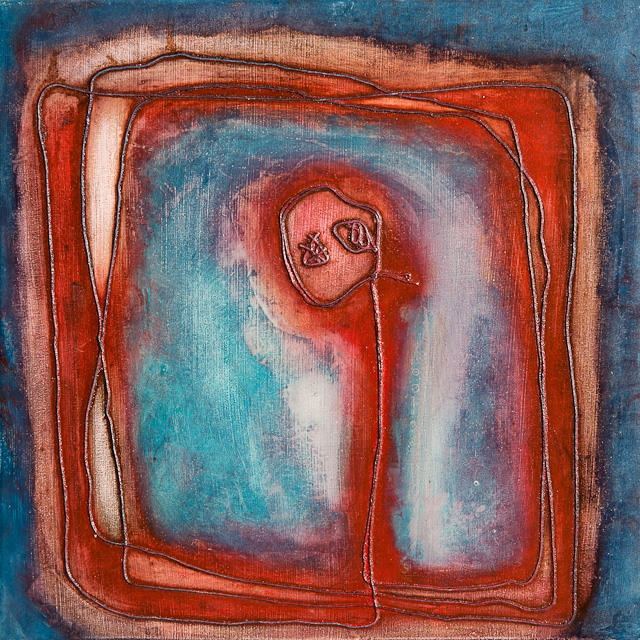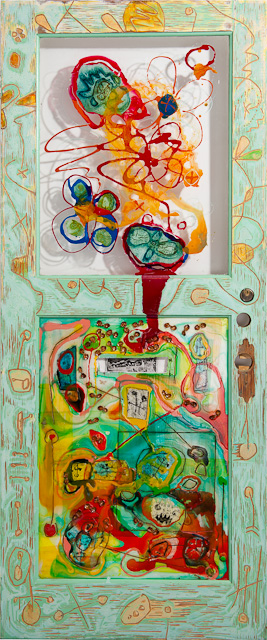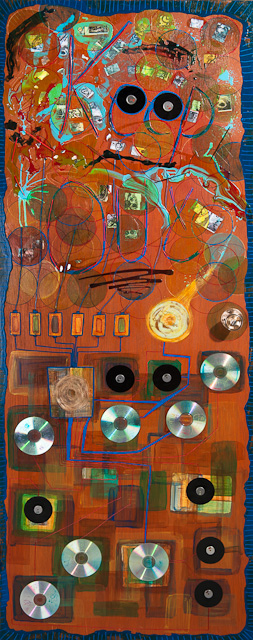joining worlds
Joining Worlds is an exploration of mark-making inspired by my son, Dylan.
When Dylan was six years old he drew a series of images repeatedly, sectioning his page into four spaces. The sixteen square runes, grouped in fours, form a key to his visual language. Rune, in Old English archaic language, means “whispering, or secret talk.” In the spirit of the word, the runes form a key to whispers from my son’s secret world.
The seven doors (Secrets) vary in size and treatment, with each door containing and repeating rune elements. Unique characteristics of each door guided their development. I found myself responding to moments experienced with Dylan and memories from my own early childhood.
Collage has played an important role in this exhibition. The characteristics and relationships between materials involved in this process are integral to creating meaning. I combined materials that have contrasting natures and suggest themes of fragility, strength, containment and growth. Characters from the runes appear in different forms, combined with collaged elements. The seven doors take a visual journey into Dylan’s world, from my point of view as his mother and artist. They create a joined world to be opened, like a door, by the imagination of the viewer.
Runes
Essay – secret talk by susan andrews grace
The runes of Joining Worlds build a cornerstone of visual language used by Natasha and her son, Dylan. These exquisite collograph plates form a matrix. Art works in their own right, they parent images on the doors as well as make hand-pulled prints. The doors suggest ages and stages of growth in the solemn walk away from childhood. Characters from the son’s imagination such as angel, goat, dirty bubble, spider, scarecrow and brother are the backbone of this language, received by his mother. Joining Worlds contains four series: characters, animals, bones and constellations that consist of four groups of four. Collage in this context comprises a visual, emotional and developmental record of communication. Natasha Smith’s printmaking virtuosity in building layers of surface and dimension on the found doors traces a journey into childhood expression.
Secrets
Secret One Gift from mother to son. If you look closely you will see a boy in the black tulle section. Yellow petals stream over his head. Encased seeds and flowers further describe mother gifts.
Secret Two Contains the wisdom of an artist walking in tall grass and looking at mosses hanging from trees. The angel rune appears in the middle of the door; acrylic transfers and prints grace the door.
Secret Three: Mother Door opens to fluidity. Its peppermint green surface invites intuitive use of colour. Both sides of the window sport original, first impressions of a constellation . This door has the power to grant wishes.
Secret Four: A door with ten windows and black and white palette suggests separation— kindergarten on the horizon. Drawing contains the door’s border with precision. Complexity of processes increases with transfers from rubbings of runes, drawings with pouring medium reflecting shadows on the wall.
Secret Five: Father Door brings to light the sacred— angels, skeletons, and dirty bubbles made concrete in clay. Ponderosa Pine needles separate clay icons; the big daddy of pine trees lends its presence. Personality of the child pushes ahead.
Secret Six: The love door came in complementary blue and red from a former chicken coop door with a window that ‘tells it slant.’ Love and pairs, hen and chick work together. Six assimilates layers and stages with rocks, bones of Mother Earth and acorns, symbol of the child.
Secret Seven: Door of independence with Keep Out sign evokes an individual while circuit boards and baby hair make a trajectory of accomplishment. Abstract plaid on the modern, masculine door hints at Dylan’s Scottish DNA. Images printed onto stickers are age-appropriate and indicate a mother’s care as does the “sewn” speaker wire.
Curatorial Essay – Through the Rabbit Hole by Deborah Thompson
Through the Rabbit Hole
How fashionable it is to be journeying down the infamous rabbit hole of Lewis Carroll’s Alice in Wonderland only to be caught between neither this realm nor that, but in the imaginal zone where visual language takes the literal for a spin. It is this imaginal zone that artist Natasha Smith is leading us with her installation, Joining Worlds. Smith began the project as a form of visual dialogue between herself and her young son Dylan. Smith, fascinated with her son’s drawings perceived them as runes or symbols from a hidden language and has used them to create a series of relief panels from which to create prints of multiple images. These runes then became catalysts for the development of a series of collaged drawings on doors that make up the focal point of the exhibition. Through Joining Worlds, Smith seeks to find a meeting place from which the secret world of her son can be accessed and amplified. Or metaphorically, we as viewers are offered a door in which to enter the realm of the imaginary world.
Her choice to use an existing object, such a door links her work with the tradition of Readymades a term coined in regards to the sculptural work of conceptual artist Marcel Duchamp (1887-1968). (When in 1917, Duchamp presented an actual urinal entitled Fountain in an exhibition at a New York art gallery. The art world was shocked. Now, of course the use of Readymades or found objects is a common practice in the art world.) Smith’s inclusion of found objects on to the surface of the doors is reminiscent of early cubist collage work and dates back to the early 20th century, as well as drawing on the artist’s own history of collage. Any found object or previously existing entity that is brought to an artwork brings with it conscious and subconscious metaphorical, psychological and symbolic associations that the viewer might have regarding the object. As the artist, Smith can give these associations some direction to by the formal choices she makes in creating and presenting the piece, such as her use of colour, lighting, texture, line elements and so on – all adding layers of meaning to this base-line association of the dominant found object in Joining Worlds – the door.
On a mundane level a door provides both an access to and a boundary between one place and another (e.g. inside and outside worlds). On a metaphysical level, the door acts as a gateway or threshold between realms, providing a way of connecting the material and the spiritual realms. Art Historian and Philosopher, AK Coomaraswamy
(1877-1947) refers in his book, Door in the Sky refers to a door as a universal metaphor for the axis mundi that mediates between realms of consciousness – this world and other. Or in the case of Joining Worlds, between the imagination of the child and the imagination of the mother.
The maternal root of the project Joining Worlds brings to mind for me the documentary work of artist Mary Kelly (1937) who after the birth of her son documented his growth in a series of art works called Post-Partum Document. The series emerged during the 1970’s at what many regard to be the height of the feminist art movement. It stood as an outcast in the male dominated art world where female artists of the time hid any evidence of a maternal or even marital life as evidence of such domestic and feminine activity lowered their chances of being taken seriously in the art world. Specifically, in Post-Partum Document, Kelly documented the development of her son’s language from his earliest mark making with crayons to his verbal speech. Much like Kelly, Smith immortalizes the drawings of her son by transposing them into printmaking plates. The child’s voice then becomes an extension of the mother’s voice and serves as a reminder of the complex and fertile ground from which the female gender emerges. As a mother of two young children, Smith knows this ground well and uses it in creating a vocabulary from which to speak.
In reading Smith’s installation Joining Worlds the viewer is witness to the artist’s manic activity of mark making across the surface of the door, glimpsing the artist’s moments of madness – of swirling, poured, scratched and overlapping lines of paint contained in the firmness of the static door. These marks are energetically similar to the late drip paintings of Jackson Pollock (1912-1956) where chaos becomes order, and order begets chaos only to be held in tension by the formal framing of the rectangle. The viewer’s identification with the enigmatic iconography strewn across the door allows for entry. Small clues to the secrets of the runes are given by the artist with such found objects as, Egg shells, bones, seeds, cones, lichen, clay and moths as well as the artist’s painted embryo like orbs, embossed cells and radiating forms adorn each door adding to the potential narrative of the piece.
In particular, I find myself isolating the embryonic or cellular like elements in the runes and doors. For example, in Secret 1 where the colourful orbs seem to reference some cosmological event expressing both form and formlessness at the same moment. These orbs reference the artist’s previous work Closed Forms and express life force energy that is reminiscent of the colourful abstract paintings of American painter Arthur Dove (1880-1946). Dove, who wrote extensively about his use of symbols abstracted from nature in his search of developing a visual language in which to explore his mystical beliefs. Like other early American Abstract painters, Dove was influenced by the writings of American transcendentalists such as David Henry Thoreau (1817-1862) and Walt Whitman (1919-1892) who embraced a movement away from the empirical ways of knowing to an intuitive way of knowing based on nature. Similarly, Smith juxtaposes the abstract forms of her son’s drawings with found objects from nature in constructing a collaborative formal language from which to create her piece.
Lastly, the achromatic treatment of Secret 4 stands in contrast to the other doors in the series. Colourless, the gestures of the mark making and runes stand naked in comparison to the colourful display of the other doors. Perhaps more than the others, this door contains the memory held in the printmaker’s plate of the mother and child relationship carved, embossed, etched and stained on to a lasting surface. A memory for Smith of the world joined by the imagination.
Deb Thompson
Curator






















